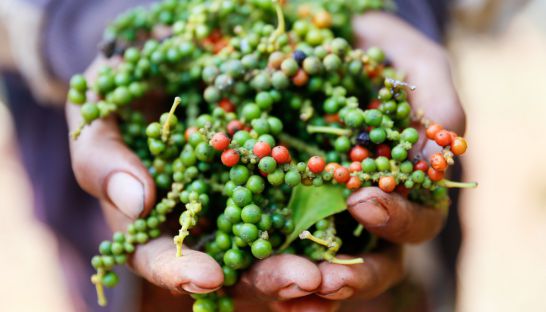Prized spice has its fans, and imitators
Prized spice has its fans, and imitators
Given the wild success of Kampot pepper, which can fetch up to three times the amount per kilo as Cambodian pepper produced without its prized label, it is hardly surprising that the product has its share of imitators.

In an effort to address the risk of knockoffs, which damage the reputation and marketing of the authentic product, the Ministry of Commerce and George Edgar, the European Union’s ambassador to Cambodia, held a joint seminar yesterday to explain to pepper producers the importance of respecting the Cambodian pepper’s Geographical Indicator (GI) status.
Kampot pepper was awarded GI status in 2010, and in February 2016 became the first Cambodian product recognised by the EU as carrying the designation. The GI label identifies and certifies the distinct geographical origin and associated qualities of a product, such as Champagne or Parmesan cheese.
Nguon Lay, president of the Kampot Pepper Promotion Association, said that despite its GI designation, Kampot pepper producers still struggle against a raft of inferior imitation products primarily geared toward the steady flow of passing tourists.
Pepper producers need to “raise public awareness of GI in order to strengthen the regulations and add value to the product”, he said. Lay added that it was up to individual producers to respect this privileged and protected status.
“We still find that around 25 percent of the market is using the Kampot pepper name without ensuring that it is actually a Kampot product or meets EU quality standards,” he said.
This was a substantial improvement, he admitted, from just last year, when a market survey carried out by the association found that 75 percent of pepper products were abusing its name.
“We are trying to get producers to understand the impact of imitation products,” he said, adding the Ministry of Commerce was ready to take action against producers caught selling imitation products.
According to the Ministry of Agriculture’s annual report, Cambodia produced 12,000 tonnes of pepper during last year’s harvest season, up from 9,800 tonnes the previous year.
Of this, only 70 tonnes was certified to carry the Kampot pepper label, about 10 tonnes more than last year. However, Lay said production was still short of demand. “Currently, we have a shortage when supplying to the international market,” he said.
“But we hope to be able to have enough hectares under cultivation by 2018.”
Kampot pepper falls into three categories with black peppercorn currently valued at $15 per kilo, red at $25, and white reaching $28 per kilo.













